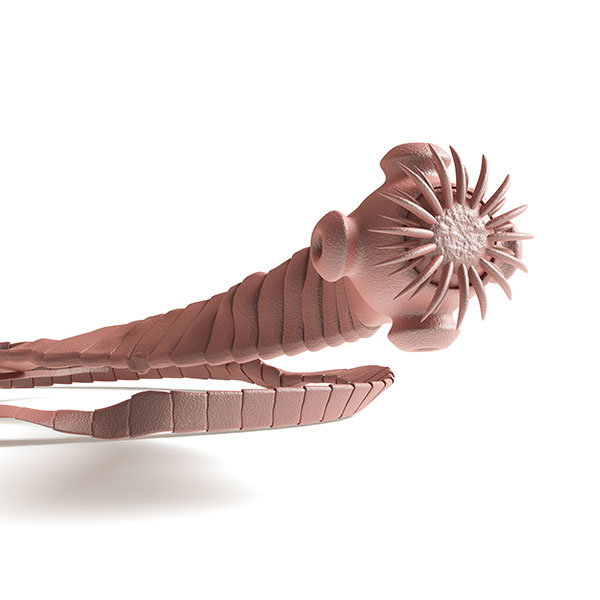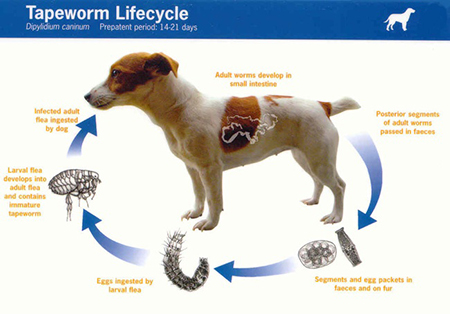Worm Segments in Your Dog’s Poop
As the tapeworm grows, some of its segments containing heaps of eggs will be released into your dog’s feces. They may also be seen around your dog’s bottom or in their bedding. These segments may look like moving pieces of rice or dried-out, hard yellow specks that can stick to your dog’s coat.
If infected, your dog may scoot around the floor or bite or lick their bottom to try to relieve the itching caused by the tapeworm. However, remember that dogs scoot for many reasons, such as blocked or irritated anal sacs or skin inflammation. Take your dog to the vet to understand what may be causing their discomfort.
As the tapeworms grow inside your dog, they may cause vomiting. Of course, vomiting can indicate a variety of other problems, from indigestion to more serious conditions. If your dog vomits frequently or displays other symptoms, such as lethargy or severe diarrhea, see the vet immediately.
In extreme cases of tapeworm infection, your dog may lose weight despite eating normally. This is due to the tapeworm feeding on the nutrients in your dog’s intestines.
Like vomiting, weight loss can have a variety of causes. If there are no obvious reasons for the weight loss, such as increased exercise or a change in diet, then your dog might need to visit a vet for assessment.
Clubs Offering:
Tapeworms are an intestinal parasite. Along with roundworm, hookworm, and whipworm, this flat, segmented worm is found in dogs, cats, humans, and many other species around the world. The most common tapeworm species is Dipylidium Caninum. The medical term for a tapeworm infestation is Cestodiasis.
If you’ve ever seen photos of tapeworms, your reaction was probably one of automatic revulsion. (Especially those alarming videos of tapeworms being removed from people. A woman in China had an eight-foot tapeworm taken out of her stomach!) Even though they’re disgusting to look at, it’s important to recognize the signs of parasites, so your dog can be treated before the worms do damage to his body. The good news is that treatment for tapeworms is very effective and simple.

A medical model of an adult tapeworm / Copyright decade3rd-anatomy online
There is a cycle through which dogs get tapeworms:

What are the Signs and Symptoms of Tapeworms in Dogs?
Dogs often do not show noticeable symptoms for a long time after infection, but that doesn’t mean you can’t spot them if you know what to look for.
What are Symptoms of Tapeworms in Dogs? How to prevent them?
Lets be honest: Dog poop is gross. But seeing worms in your dogs poop is even grosser. If youve noticed something strange going on in your dogs poo, tapeworms could be to blame. The pesky intestinal parasite is unfortunately common and its not rare for your pooch to be infected at least once in his life. Luckily, tapeworms in dogs rarely cause disease, and both treatment and prevention are relatively simple.
Tapeworms are long, flat, white segmented parasites with hook-like mouth parts that they use to attach themselves to the intestinal walls of pets, says Jessica Nichols, DVM, who is the chief veterinary officer of Spay and Neuter Kansas City in Kansas City, Mo. While there are multiple types, or species, of tapeworms that can infect dogs, the Centers for Disease Control and Prevention (CDC) lists Dipylidium caninum as the most common one in the United States. However, the Companion Animal Parasite Council (CAPC), an independent nonprofit led by veterinary professionals and parasite experts, adds that Taenia species are also common in North America.
Wondering what tapeworms look like, and how to identify them if you suspect your dog is infected? It might be easier to spot these parasites than you think. According to Nichols, adult tapeworms will shed segments of their body (called proglottids) into the infected dogs poop. These segments are fairly easy to spot with the naked eye—they tend to look like grains of rice that move, she explains. Proglottids from Dipylidium caninum look so similar to cucumber seeds that the species is often referred to as the cucumber seed tapeworm.
Tapeworm segments are commonly seen in the dogs poop, near his rear end, and in his living area (like bedding or his favorite spot to perch on the couch). If you spot them, act quickly with a call to your veterinarian—these little segments will eventually break open to release tapeworm eggs into the environment. Gross!
If you spot signs of tapeworms, youll probably want to know how the parasite infected your pup. Dogs are infected with tapeworms through an intermediate host. In other words, dogs arent directly infected from interacting with the eggs that are released into the environment. The eggs must first be eaten by an intermediate host—like fleas or rodents—and then the dog becomes infected by eating the host.